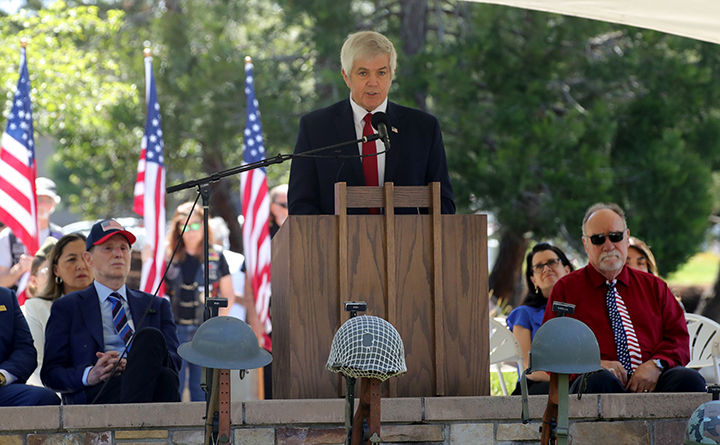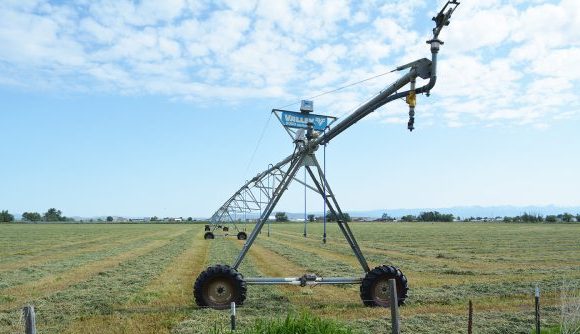Fighting fire in own backyard brings it home
Published 7:00 am Wednesday, July 28, 2021

- Fire retardant residue coats the countryside on Thursday, July 22, 2021 at the Elbow Creek Fire near Promise.
PROMISE — Fighting a wildfire is no easy task, but it becomes more meaningful when it’s in your own backyard. That’s what Jeff Weer said from the front line of the Elbow Creek Fire near Promise on Thursday, July 22.
“It’s hard work, it’s smoky, it’s fun. I wouldn’t do this job if I didn’t enjoy doing it,” he said at the Bar-B Ranch staging area south of Promise. “I just enjoy being out in the field, I enjoy the camaraderie of the crews and the folks involved.”
His wife, Maria, is fully supportive of her husband’s passion for fighting wildfire.
“I think that I am proud to see him be able to help our community in this way,” she said. “I know fighting fires is his passion and he’s in his element. He’s happy he can make a difference.”
The couple has a ranch near Lostine, making it somewhat convenient for Jeff to make it to work each day.
“I live here locally. I can go home and sleep in my own bed — it’s a 15-minute drive from my house to the fire camp,” he said. “So I’m fortunate to be able to have done that. There’s several nights I did stay up here.”
But even when he’s sent to fires elsewhere, it’s still part of his passion.
“I’m happy to be here. A lot of times we get sent to other places, other parts of the state or the country to fight fire,” Jeff said. “I wasn’t born and raised in Wallowa County but I’ve lived here (and worked) for the U.S. Forest Service working on my 17th year. It’s all been here in this district.”
There since the outbreak
Jeff is an engine captain with the U.S. Forest Service. On the Elbow Creek Fire he’s the supervisor trainee on Division Tango. He’s been on the fire since it was first reported a week ago.
“My sole focus is on Division Tango,” he said, but added that his concern also is tying in with neighboring Divisions Mike and Whiskey. “We’ve had our rough patches, but we’re holding our own.”
He has a good grasp on the progress.
“We’ve got people down there, we’ve got an indirect dozer line in, meaning it’s not tied in against the fireline, against the black,” he said. “There’s unburned material between the dozer line and the black and we’re trying to keep it from jumping over the dozer line. We’re trying to get that line tighter and get crews in there to put that line tight against the black.”
His approximately 120 firefighters are hard at it.
“They use normal wildland firefighting tools — pulaskis, shovels — and putting in hose lays,” he said. “We have big tanks of water at the top of a drainage and run hoses down to the bottom of the drainage … and we branch other hoses off of it and take it out in the woods and try to get a mop-up … 25 feet around the entire perimeter of our division. We’re working on that slowly but surely.”
Brett Deedon, a trainee public information officer with the state Fire Marshal’s Office, said there are about 1,000 firefighters on the entire fire.
“And that’s continuing to grow by the hour,” he said.
Deedon said that with resources in Oregon becoming more scarce, aid is coming from other states. While in the Promise area Thursday, several trucks from Idaho passed by. He said there also are resources from Arizona and even a PIO from Louisiana.
Contract firefighter
Another firefighter told how difficult the work is. Juan Mora, of Salem, has been battling blazes since 2000 and is now a contract firefighter. He arrived on the fire early Thursday and began checking out the situation.
“It’s hard work. … I like to check the whole ground I’m going to be working on first,” Mora said from Sloan Point, a staging area for Division Whiskey. He said highly trained hotshot firefighters were down Grossman Creek.
“It looks like it’s holding, but you never know with the winds you’ve had. It could pick up,” he said. “You do put in work. It’s not just a hike in the woods. We take it seriously. We work all year long on the forests. We plant, we thin, it’s not just a hike in the woods. It’s a lot of stuff like dry-mopping and harder stuff.”
Dry-mopping, he said, is to use a pulaski to dig 2 feet of dirt to cover any burning or flammable material.
“What you’re doing is taking out the oxygen from the fire,” he said.
Bringing it home
But knowing the people here brings it home all the more.
“When the fire’s in your own back yard, per se, I don’t want to say it’s more important — all fires are important — but I have a lot more ownership in it locally,” Jeff Weer said. “There are people out here who have lost a family cabin and I’m friends with those folks, so that hits harder.”
While proud of the efforts of her husband and other firefighters, wife Maria is still concerned for their safety.
“I do worry about their safety, but I know that they train to be as safe as possible,” she said.
She also emphasized the support offered by the community.
“We’re thankful for the community support. People always reaching out to see if I need help with carpools and the like,” she said. “People are supportive of the firefighters, but they’re also supportive of those of us at home.”
Jeff Weer emphasized that firefighters in Wallowa County have a good relationship with their colleagues from elsewhere.
“We have a really good working relationship with our ODF (Oregon Department of Forestry) partners in Wallowa County,” Jeff said. “We’re kind of landlocked up here so we rely heavily on each other for mutual aid.”









